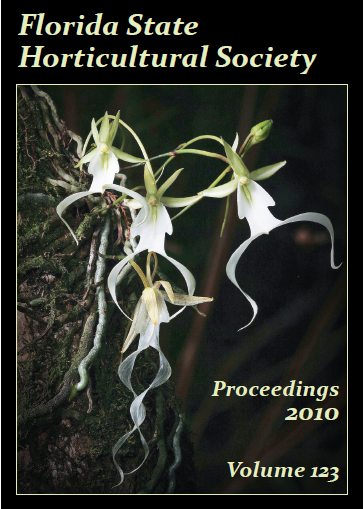Krome Memorial Institute (Tropicals)
Abstract
Growing raspberries in southern United States is a challenging task as they are high chill-loving plants. Cultivation of raspberry in Florida is significantly hampered due to prevailing hot and humid conditions. The characteristics of raspberry cultivars have been categorized based on morphological descriptions that are dependent on the environment. With this view our program is geared toward identifying low chill/high temperature raspberry genotypes. In this regard, genetic diversity among raspberry cultivars being evaluated in our breeding program for low-chill/high temperature tolerance was assessed employing molecular techniques. A high quality DNA was isolated from raspberry leaf tissue and subjected to molecular analysis. DNA typing was carried out using RAPD assay. Of the 100 primers screened, 10 primers yielded 142 usable DNA bands. Pairwise comparisons of unique and shared amplification products were used to construct a phylogenetic tree using Euclidean linkage distances that clearly separated low- and high-chill raspberry genotypes. These data showed the potentiality of RAPD markers for assessing genetic diversity among raspberry cultivars. Further studies coupled with field analysis would aid in identifying low-chill/high temperature fruit set raspberry genotypes useful for developing raspberry cultivars suitable for Florida.References
- Anonymous. 2010. Blackberries and raspberries (Rubus spp.). Available at: <http://www.uga.edu/fruit/rubus.html>.
- Fernández, M.P., S. Hernáiz, and J. Ibáñez. 2008. Genetic characterization of raspberry cultivars using molecular markers. Acta Hort. 777:125–132.
- Graham, J., I. Hein, and W. Powell. 2007. Raspberry, p. 207–216. In: C. Kole (ed.). Genome mapping and molecular breeding in plants, Vol. 4. Springer, Berlin, Heidelberg, Germany.
- Kumar, N.V.H., P. Narayanaswamy., D.T. Prasad., G.K. Mukunda, and S.N. Sondur. 2001. Estimation of genetic diversity of commercial mango (Mangifera indica L.) cultivars using RAPD markers. J. Hort. Sci. Biotechnol. 76(5):529–533.
- Patamsyte, J., Z. Donatas., L. Juozas., B. Virgilijus., B. Laimute, K. Violeta, and R. Vytautas. 2009. Study of genetic diversity in wild raspberry (Rubus idaeus L.) germplasm collection using morphological characters and RAPD markers. Biologija 54(2):66–74.
- Stafne, E.T., J.R. Clark., M.C. Pelto, and J.T. Lindstrom. 2003. Discrimination of Rubus cultivars using RAPD markers and pedigree analysis. Acta. Hort. 626:119–124.
- Williams, J.G.K., A.R. Kubelik., K.J. Livak., J.A. Rafalski, and S.V. Tingey. 1990. DNA polymorphisms amplified by arbitrary primers are useful as genetic markers. Nucleic Acids Res. 18:6531–6535.

